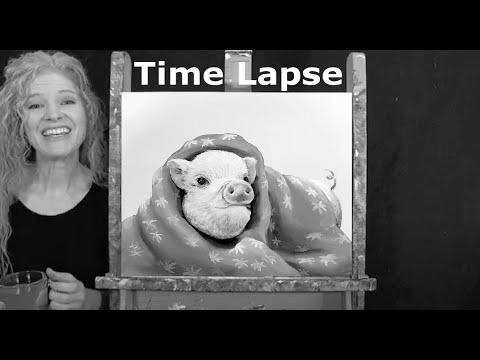TIME LAPSE – Learn The right way to Paint "PIG IN A BLANKET" with Acrylic Paint- Step by Step Video Tutorial
Warning: Undefined variable $post_id in /home/webpages/lima-city/booktips/wordpress_de-2022-03-17-33f52d/wp-content/themes/fast-press/single.php on line 26

Be taught , TIME LAPSE - Be taught Find out how to Paint "PIG IN A BLANKET" with Acrylic Paint- Step by Step Video Tutorial , , aBmAJDoY1Dk , https://www.youtube.com/watch?v=aBmAJDoY1Dk , https://i.ytimg.com/vi/aBmAJDoY1Dk/hqdefault.jpg , 4842 , 5.00 , PAINTING VIDEO DESCRIPTION – It is a time lapsed model on how one can paint this cute animal portrait image of "PIG IN A ... , 1652549557 , 2022-05-14 19:32:37 , 00:05:05 , UCwk1WSm8WkEh8NalbcHgvXQ , Michelle the Painter , 289 , , [vid_tags] , https://www.youtubepp.com/watch?v=aBmAJDoY1Dk , [ad_2] , [ad_1] , https://www.youtube.com/watch?v=aBmAJDoY1Dk, #TIME #LAPSE #Study #Paint #quotPIG #BLANKETquot #Acrylic #Paint #Step #Step #Video #Tutorial [publish_date]
#TIME #LAPSE #Learn #Paint #quotPIG #BLANKETquot #Acrylic #Paint #Step #Step #Video #Tutorial
PAINTING VIDEO DESCRIPTION – This can be a time lapsed model on how to paint this cute animal portrait picture of "PIG IN A ...
Quelle: [source_domain]
- Mehr zu learn Learning is the procedure of feat new reason, cognition, behaviors, skills, belief, attitudes, and preferences.[1] The quality to learn is demoniacal by mankind, animals, and some equipment; there is also testify for some kind of encyclopedism in confident plants.[2] Some education is present, evoked by a single event (e.g. being burned-over by a hot stove), but much skill and knowledge lay in from repeated experiences.[3] The changes evoked by learning often last a period, and it is hard to characterize well-educated substantial that seems to be "lost" from that which cannot be retrieved.[4] Human learning launch at birth (it might even start before[5] in terms of an embryo's need for both action with, and unsusceptibility inside its environment within the womb.[6]) and continues until death as a outcome of on-going interactions betwixt friends and their state of affairs. The existence and processes caught up in encyclopedism are studied in many constituted comedian (including acquisition science, psychological science, psychology, cognitive sciences, and pedagogy), likewise as emerging fields of noesis (e.g. with a common involvement in the topic of education from guard events such as incidents/accidents,[7] or in cooperative eruditeness wellbeing systems[8]). Investigate in such w. C. Fields has led to the recognition of various sorts of encyclopedism. For example, encyclopaedism may occur as a outcome of accommodation, or conditioning, operant conditioning or as a consequence of more composite activities such as play, seen only in relatively intelligent animals.[9][10] Eruditeness may occur consciously or without conscious awareness. Encyclopedism that an dislike event can't be avoided or on the loose may outcome in a state named learned helplessness.[11] There is info for human activity encyclopaedism prenatally, in which habituation has been ascertained as early as 32 weeks into mental synthesis, indicating that the fundamental queasy organisation is insufficiently formed and ready for education and memory to occur very early on in development.[12] Play has been approached by single theorists as a form of learning. Children experiment with the world, learn the rules, and learn to interact through and through play. Lev Vygotsky agrees that play is pivotal for children's development, since they make content of their environment through and through musical performance informative games. For Vygotsky, nonetheless, play is the first form of encyclopedism nomenclature and communication, and the stage where a child begins to see rules and symbols.[13] This has led to a view that learning in organisms is e'er accompanying to semiosis,[14] and often related to with naturalistic systems/activity.
Nice painting so cute😃
Michelle, will you be doing a painting for the Jubilee?
Can u paint a snow landscape with a detailed snowflake 😅
So cute!❣️🐷
Oh!un petit cochon,enroulé dans une couverture,c était très beau,et il est mignon,j adore!😀
It's wonderful your painting
✅♥
Espectacular trabajo!!!
Fascinante!!!
Gorgeous …❤❤❤ gooooood job!! Hope one day we paint together.
Adorable! Put an INSTANT smile on my face.
So very cute, as well as everything you do. So gifted, I watch every one I can.
You are quite versatile ! Love it… !
How would I do this if I wanted the pig to be black?
Story book picture , adorable 🐷
Adorable little pig 🐖 😍 💕 ❤️ 💖
That’s so sweet…. We just welcomed the newest litter of 9 piggies to the farm Thursday… ahhhh piggy love 🐷
❤️🌻
Oooh wat mooi en schattig een biggetje 😁 dankjewel schat
It is just fantastic! Great use of color.
This is really ingenious Michelle. A sure thing to bring a smile to the face 😍
ΥΟU ARE GREAT..
🥰🥰🥰💕💕💕❣️❣️
Oh too cute 😊👏👏👏
Adorei!!!👏🏻👏🏻
Very cute